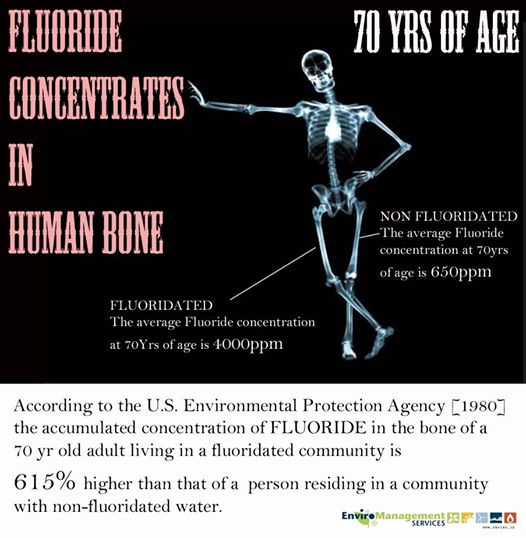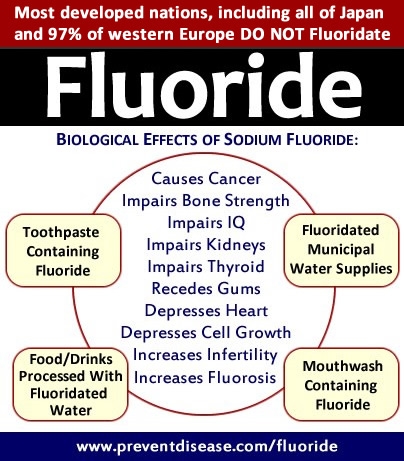We know that many New Zealand children are receiving a toxic dose. At least 30% of children in fluoridated areas have some form of dental fluorosis. This is seen as white spots or disclouration of the teeth.
This is the first outward sign of fluoride poisoning. This is similar to the thin blue line on the gum (Burton’s Line) which signals lead or other heavy metal over-exposure or poisoning. It is medically negligent for fluoridation promoters to dismiss this serious side effect as merely “cosmetic.”
High risk populations receiving unmonitored doses
People living in fluoridated areas often suffer adverse effects from fluoride ingestion, as they more easily exceed the upper limit, depending on their water consumption, diet, genetic predispositions, dental product use and medical conditions.
Examples:
1) IQ and brain function
In 2023 the final draft version of the US Government’s National Toxicology Program’s (NTP) six year review of fluoride and IQ, was released. The final version is due before the end of 2023. The NTP has produced a Monograph and a Meta-analysis. This draft of the meta-analysis contains the reviewers comments and the replies by the NTP. The NTP found fluoride is neurotoxic to humans and they could not find a dose where fluoride does not cause neurological harm.
A really good summary of the review can be found on the Fluoride Action Network’s page Fluoride is the New Lead.
According to the US Government’s National Research Council’s 517 page publication Fluorides in Drinking Water, fluoride can damage the brain. Animal studies conducted in the 1990s by EPA scientists found dementia-like effects at the same concentration (1 ppm) used to fluoridate water, while human studies have found adverse effects on IQ at levels as low as 0.9 ppm among children with nutrient deficiencies, and 1.8 ppm among children with adequate nutrient intake. This is the fluoride ingestion range for many people in fluoridated communities. Fluoride has now been included on the list of known neurotoxins, as published in The Lancet in 2014
2) Thyroid, metabolism and mood disruption
The National Research Council (NRC) also found fluoride to be an “endocrine disruptor.” Most notably, the NRC has warned that dosages of 0.05-0.13 mg/kg/day when iodine intake is adequate and 0.01-0.03 mg/kg/day when iodine intake is inadequate is likely to effect thyroid function. These dosages are exceeded by many New Zealanders. Bottle fed babies are likely to exceed these dosages at times. Reduction of thyroid activity can lead to loss of mental acuity, depression, weight gain and effect brain development.
3) Bones and teeth fracture risks.
According to the NRC, fluoride can diminish bone strength and increase the risk for bone fracture. While the NRC was unable to determine what level of fluoride is safe for bones, it noted that the best available information suggests that fracture risk may be increased at water concentrations as low 1.5 ppm, which is only slightly higher than the concentration (0.7-1 ppm) recommended for fluoridation in New Zealand.
4) Risk for bone cancer
Animal and human studies have found a connection between fluoride and a serious form of bone cancer (osteosarcoma) in males under the age of 20. The most important study was done by Bassin et al and published in Cancer Causes and Controls in 2006. This study found that boys were at a much greater risk of developing osteosarcoma in their teens if they were exposed to fluoridation between the ages of 6 and 8. This study has never been refuted as no other study has looked at age of exposure. The connection between fluoride and osteosarcoma has been described by the National Toxicology Program as “biologically plausible.” Up to half of adolescents who develop osteosarcoma die within a few years of diagnosis.
5) Kidney patients’ fluoride toxicity
People with kidney disease have a heightened susceptibility to fluoride toxicity. The heightened risk stems from an impaired ability to excrete fluoride from the body. As a result, toxic levels of fluoride can accumulate in the bones, intensify the toxicity of aluminum build-up, and cause or exacerbate a painful bone disease known as renal osteodystrophy.
6) Enzyme disruptor
From as early as 1950 researchers have known that fluoride is a toxic substance that is used in enzyme chemistry to poison enzymes. Enzymes are essential catalysts for the many biochemical reactions in the body.
7) Industrial fluorides versus naturally occurring
The industrial chemicals used to fluoridate water may present unique health risks not found with naturally-occurring fluoride complexes . The chemicals – fluorosilicic acid, sodium silicofluoride, and sodium fluoride – used to fluoridate drinking water are industrial waste products from the phosphate fertilizer industry. Of these chemicals, hydrofluorosilicic acid (HFSA) is the most widely used. HFSA is a corrosive acid which has been linked to higher blood lead levels in children. A recent study from the University of North Carolina found that HFSA can – in combination with chlorinated compounds – leach lead from brass joints in water pipes, while a recent study from the University of Maryland suggests that the effect of fluoridation chemicals on blood lead levels may be greatest in houses built prior to 1946. Lead is a neurotoxin that can cause learning disabilities and behavioral problems in children.
8) Fluoridated water is NOT recommended for babies
In November of 2006, the American Dental Association (ADA) advised that parents should avoid giving babies fluoridated water. Other dental researchers have made similar recommendations over the past decade.
Babies exposed to fluoride are at high risk of developing dental fluorosis – a permanent tooth defect caused by fluoride damaging the cells which form the teeth. Other tissues in the body may also be affected by early-life exposures to fluoride. According to a recent review published in the medical journal The Lancet, fluoride may damage the developing brain, causing learning deficits and other problems.
For more information on the harmful effects of fluoride see the world’s largest database of fluoride studies at the FAN Study Tracker





